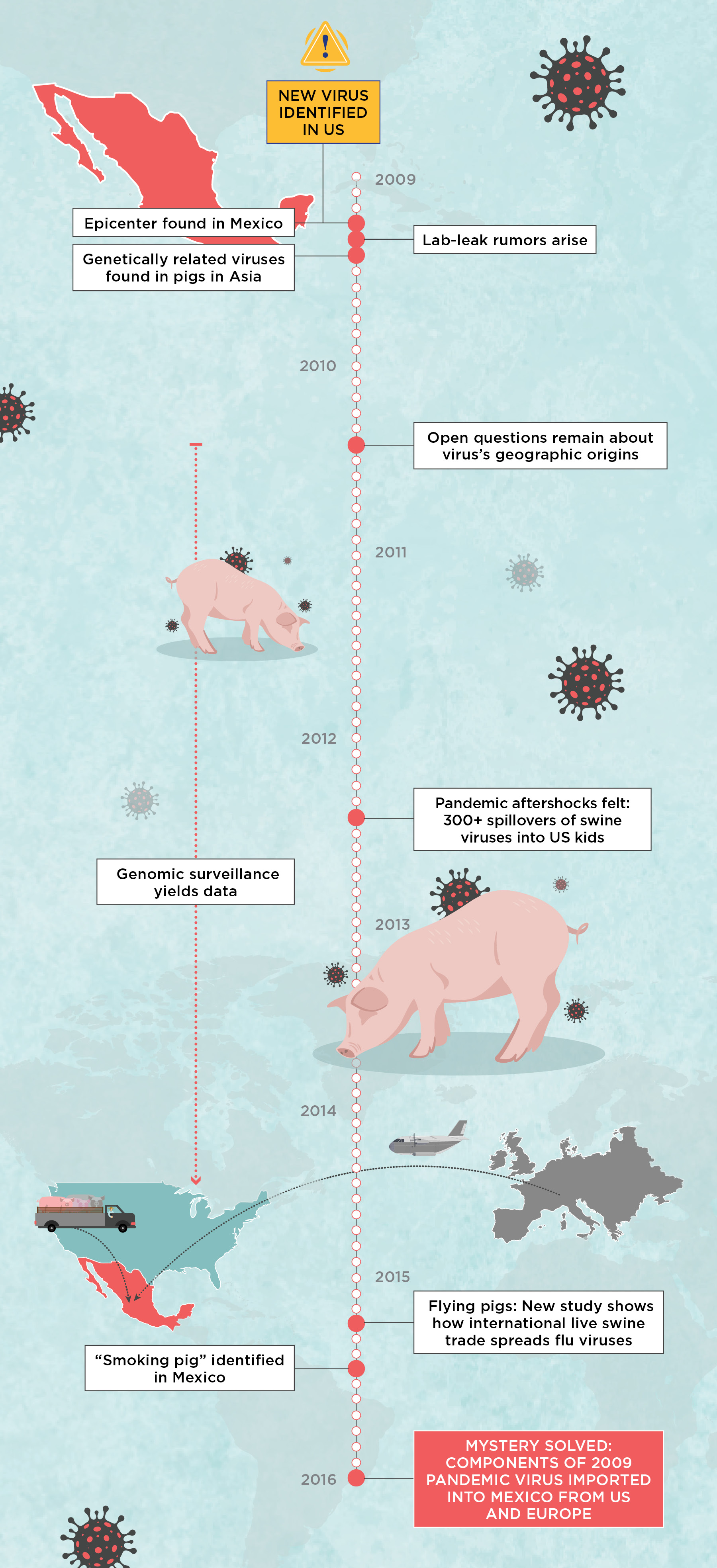It was a long journey to figure out what led to the 2009 H1N1 pandemic, but eventually the work not only solved the pandemic’s origins, but also yielded results that should serve as a warning sign: we do not have the surveillance infrastructure in place to track fast-moving and intermixing pathogens inadvertently shipped around the world as livestock operations grow to support an expanding human population. Here are some of the major stops on our journey to tell the pandemic’s origin story.

New virus identified in US
In April 2009, the Centers for Disease Control and Prevention (CDC) announces the identification of a new influenza A virus in two children in San Diego, California. The virus’s genome includes segments derived from the Eurasian, classical, and “triple-reassortant” swine influenza lineages. It remains unclear whether the virus is connected to mysterious pneumonia outbreaks reported earlier that month in Mexico.
Epicenter found in Mexico
Retrospective diagnostic testing confirms that the same swine-origin virus caused outbreaks in central Mexico as early as March 2009, establishing the country as the epicenter of an outbreak now rapidly spreading around the world.
Lab-leak rumors arise
Just as flights are canceled to Mexico and schools shutter in parts of the US, Japan, and elsewhere, Australian biologist Adrian Gibbs claims to have evidence that the virus originated in a laboratory performing genetic experiments for vaccine production. His arguments include that there are no known influenza viruses in pigs that are genetically similar to the viruses identified in people in Mexico and California, and that the virus’s proteins have a preponderance of lysine residues, thought to arise during vaccine production.
Genetically related viruses found in pigs in Asia
Just as the WHO declares H1N1 to be a global pandemic, studies published in Science and Nature in June 2009 conclude that the virus is of natural swine origin and outline how it evolved over decades as influenza viruses continuously jumped among birds, humans, and pigs. All five WHO collaborating influenza centers agree. The data presented in the Nature paper are compatible with the idea that the virus arose in Asia, where US health officials had expected the next pandemic to start, after close calls with SARS and bird flu outbreaks in China.
Open questions remain about virus’s geographic origins
At an informal meeting in Leuven, Belgium, in mid-2010, my colleagues and I struggle to explain how a virus in an Asian pig sparked a pandemic that began in humans in Mexico. We admit it doesn’t make sense.
Genomic surveillance yields data
Genomic sequences of flu viruses collected from pigs around the world between 2010 and 2015 capture the widespread movement of viral lineages following the direction of swine imports and exports. New discoveries are made in South America, where flu viruses introduced to pigs from humans have been hiding out for decades. Still, nothing points to the 2009 pandemic arising outside of Asia.
Pandemic aftershocks felt: 300+ spillovers of swine viruses into US kids
More than 300 children in the US Midwest catch novel flu viruses from their show pigs in the summer of 2012. These viruses carry genetic pieces closely related to the pandemic virus and are apparently the result of humans passing the virus to pigs. Fortunately, this time human-to-human transmission is never established.
Flying pigs: New study shows how international live swine trade spreads flu viruses
A simulation published in March 2015 shows the dynamic nature of pig imports and exports, with some countries such as the US acting as swine influenza “sources” and others, including Mexico, as “sinks.”
“Smoking pig” identified in Mexico
Genetic analysis of swine flu viruses from Mexico reveals 18 that match the 2009 viral lineage segment-for-segment, confirming the central region of the country as the likely site where the virus jumped from pigs to humans.
Mystery solved: Components of 2009 pandemic virus imported into Mexico from US and Europe
Reconstructing the detailed evolutionary history of influenza viruses in Mexico all the way back to the 1990s, we formulate the whole story: Over the past two decades Mexico imported millions of US pigs, including some carrying classical and triple-reassortant viruses, which spread across much of the country, while imports from Europe to central Mexico brought with them Eurasian swine viruses. This created a mixing bowl where American- and European-origin viruses reassorted into a new pathogen that made the jump to humans.
Read the full story.
